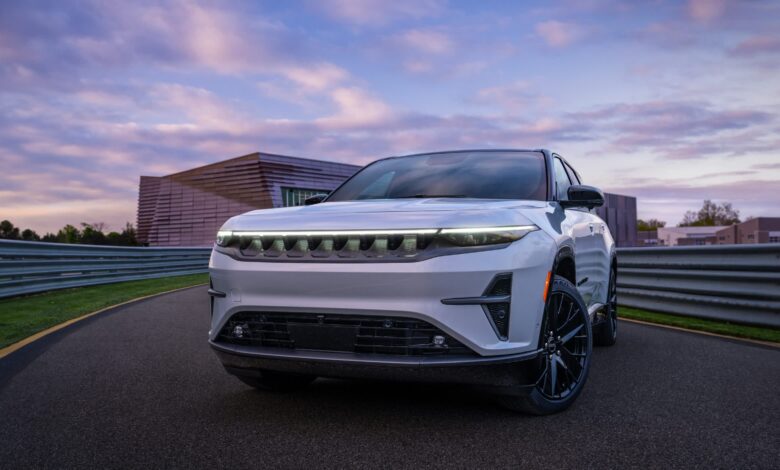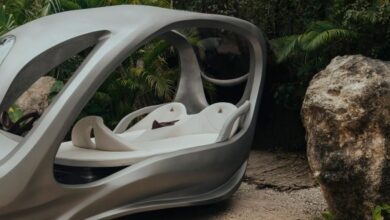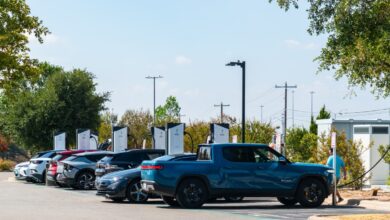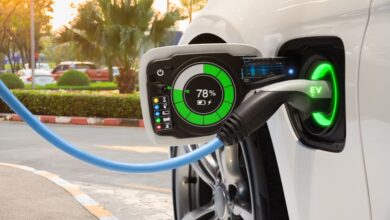Jeep’s first global all-electric SUV at $72,000

“This represents a lot. It is the first global [all-electric vehicle] built in North America, designed in the U.S. … for the world,” Jeep CEO Antonio Filosa told CNBC during an interview after revealing the vehicle. “It is a milestone in our history.”
Filosa, who started leading Jeep in December, said the brand is in “fantastic shape” but it’s in the midst of a “transition like all the automotive brands nowadays” involving electrification.
Despite a slower than expected adoption of EVs in the U.S., Filosa said the brand is not worried about consumer adoption because its additive to the Jeep’s lineup, which will continue to offer traditional gas-powered SUVs, plug-in hybrid electric vehicles and “extended-range” electric vehicles starting next year.
Jeep Wagoneer S EV concept
Michael Wayland / CNBC
A “Launch Edition” of the Wagoneer S will initially be available with a 400-volt, 100-kilowatt-hour battery pack capable of more than 300 miles on a single charge, 600 horsepower and 617 pound-feet of torque for a 0-60 mph acceleration of 3.4 seconds. It is capable of charging from 20%-80% in 23 minutes using a DC Fast charger, according to the company.
Jeep also revealed a Trailhawk off-road performance concept of the EV, which Filosa said “hopefully soon will become a product.”
Filosa said less expensive models of the Wagoneer S will start being released roughly six months after the Launch Edition.
The $71,995 starting price of the Wagoneer S EV sits between gas-powered versions of the Wagoneer, starting at about $63,000, and more luxurious Grand Wagoneer, starting at roughly $92,000.
Jeep also will introduce a new unnamed midsize SUV next year to replace its discontinued Cherokee, Filosa said.
2024 Jeep Wagoneer S EV
Jeep
He also said the company will release electric, extended-range versions of the traditional gas-powered Wagoneer and Grand Wagoneer in 2025. The technology, which uses an engine as a gas-powered generator in addition to EV batteries, is expected to debut on the upcoming Ram Ramcharger pickup truck.
The Wagoneer S is the beginning of what Stellantis CEO Carlos Tavares this week called the automaker’s EV offensive for the U.S., including six to eight all-electric vehicles this year.
“There is a huge amount of opportunities here in the U.S. We are just starting the offensive of our electrification,” Tavares said Wednesday during a Bernstein investor conference.
For Jeep, the Wagoneer S is expected to be followed by a Wrangler-inspired off-road vehicle called the Recon later this year and a new roughly $25,000 EV “very soon,” Tavares said Wednesday without disclosing additional details.
Stellantis CEO Carlos Tavares holds a news conference after meeting with unions, in Turin, Italy, March 31, 2022.
Massimo Pinca | Reuters
For years, Tavares has been outspoken about the company being forced to produce EVs, which cost 40% more, due to regulatory requirements and not consumer demand. On Wednesday, he described EVs as a “cost-cutting exercise” to ensure the vehicles are profitable.
The EVs are a shift for Jeep in the U.S., where the brand has been focusing on plug-in hybrid electric vehicles, or PHEVs, such as its Wrangler and Grand Cherokee SUVs. The plug-in vehicles accounted for 17.5% of Jeep’s sales this year.
Filosa said Jeep, which is currently No. 1 in PHEVs in the U.S., expects to continue growing sales of those vehicles in addition to the upcoming EVs.
“Electrification to us so far has been working very, very well. Basically,” he said during the reveal event, “we built the PHEV industry. We own this part of the market.
Jeep Wagoneer S Trailhawk EV concept
Michael Wayland / CNBC
Stellantis’ total PHEV U.S. sales last year was nearly 143,000, up 124% compared to 2022. Leading the way was Jeep, including 67,429 Jeep Wrangler and 45,684 Jeep Grand Cherokee “4xe” SUVs.
Jeep is using 4xe badging as a play on the brand’s off-road reputation combined with electrification, including EVs and PHEVs.
The Wagoneer S is Jeep’s first “global” EV, according to the company. The Jeep brand’s first EV model called the Avenger, a small SUV starting at about 35,000 euros, or about $37,800, went on sale last year in Europe.
The Wagoneer S, which will be produced at a plant in Mexico, is based on Stellantis’ large EV platform, which is expected to underpin eight vehicles for the company from 2024-2026.
2024 Jeep Wagoneer S EV “R-Wing”
Jeep
Despite sharing the “Wagoneer” name with Jeep’s current gas-powered model, the five-passenger, two-row EV shares little with its three-row traditional internal combustion engine counterpart other than some Jeep styling.
The most notable difference on the exterior is a more modern interpretation of the brand’s iconic seven-slotted grille, which the EV doesn’t actually need for cooling. It’s indented and the slots are solid and interconnected with one another compared to seven separate slots.
“We reinvented the traditional seven-slot grille,” said Ralph Gilles, Stellantis head of design. “I am so damn proud of this.”
The Wagoneer S also features a large “R-Wing,” an open spoiler on the back of the SUV. Gilles said the goal was to not make a “jellybean” like many EVs with good aerodynamics currently being sold in the U.S.
The Wagoneer S is far less boxy that the gasoline model, assisting in it in being the most aerodynamic Jeep ever produced by the brand, the company said.
Stellantis design chief Ralph Gilles during the unveiling of the Jeep Wagoneer S EV on May 30, 2024 in New York City.
Michael Wayland / CNBC
Gilles said the Wagoneer name is more representative of the luxuriousness of the vehicle rather than a singular design.
Inside the vehicle more than 45 inches of screens, including a 12.3-inch center display, and a mix of metal, fake leather and other sustainable materials.
Gilles, a longtime renowned car designer with the company, said wood was banned from the interior of the vehicle. It also doesn’t feature any chrome on the exterior of the SUV. Those decisions were made following input from younger designers to make the vehicle more sustainable and attractive for more youthful buyers.
“If this is going to be a green vehicle, we had to rethink the materials inside,” Gilles said. “There was a huge push for sustainable materials everywhere.”



